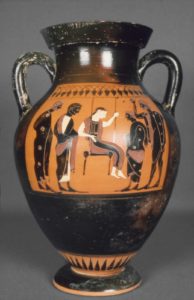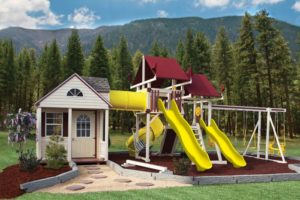Swing Set vs Playset
Swing set vs Playset ~ Is there a difference?
So, just what exactly is the difference between a swing set and a playset? Both terms are used to refer to an outdoor play center for children. Other terms are also used to refer to the same thing, such as playscape, play equipment, play system, jungle gym, etc.
History of the Swing Set

Did you know that in Greece, they have found paintings on vases depicting swings from as early as 500BC? They have been around a long time and were usually home-made contraptions made from whatever was available.
In the late 1800’s the mind-set toward children and the value of their play in education began to change — about the same time that children were required to attend school instead of work. There was a need to allow them to play safely during the school day, and the concept of a playground came about.
A lot of focus was made on providing a safe playground by making it sturdy. So in the early 20th century, most of the structures were made from steel and were focused on swings. In addition to the already popular swing, the “jungle gym” became a very popular part of the playground.
According to Wikipedia the first jungle gym was invented in 1920 and patented by lawyer Sebastian Hinton in Chicago, who trademarked the name “Junglegym”. The term “monkey bars” appears at least as far back as the 1930s, though Hinton’s initial patent of 1920 appeals to the “monkey instinct” in claiming the benefits of climbing as exercise and play for children, and his improvement patents later that year refer to monkeys shaking the bars of a cage, children swinging on a “monkey runway”, and the game of “monkey tag”.
Development of the Playset

After WWII, manufacturers began adapting playground equipment on a smaller scale to make it more appealing to the average homeowner. Commonly referred to as “swing sets”, the playground equipment became a popular part of a family’s backyard. The swing set continually evolved throughout the years with a variety of gliders, swings, slides, teeter-totters, monkey bars, and jungle gyms.
The early playground equipment was sturdy, but steel was not necessarily the best material to help prevent injuries. It was not until the late 1970’s/early 1980’s that companies began to experiment with making playground equipment from softer materials, such as wood and plastic. (If you are interested in learning more about playground safety, read our article on Playground Safety Tips.)
This change in materials also introduced more changes in the swing set. Manufacturers started integrating forts, tube slides, playhouses, sandboxes, and a whole variety of customized options that encourage imagination and creative play. Thus, the term playsets began to grow in popularity.
What’s in a Name?

Historically, a home play center for children was typically referred to as a swing set. In the past few decades, however, the unit has become so much more. The metal poles, chains, and rivets of the past (that held various types of swings and slides together), have grown and changed and there is no end to what can be included in today’s home playground.
The activities normally include swings, so the term swing set is appropriate. Frequently other activities are also a part of the play center; hence the term playset applies as well. We use the terms interchangeably, though we tend to use the term “swing set” for parts of the play center that are for swinging and “playset” for a complete play center.
We prefer the term “playset,” as it invokes imagery of imaginative children playing outside in the fresh air, enjoying hours of fun and creating cherished memories of their childhood. A playset provides much more than just physical enjoyment; it encourages creativity, spurs imagination, and helps develop problem solving and social skills.
